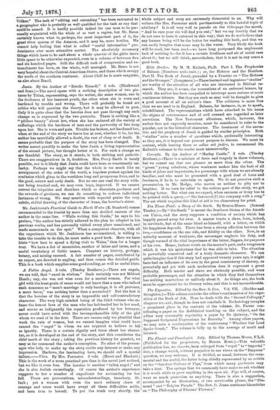Ania. By the Author of "Estelle Russell." 3 vols. (Blackwood
and Sons.)—The novel opens with a striking description of two pic- tures by Titian, representing, says the writer, the same woman, one in the freshness of her innocent youth, the other when she is worn and hardened by trouble and wrong. There will probably be found art critics who will question the theory, but it may be allowed to pass. Only it is quite clear that the heroine does not pass through any such change as is expressed by the two portraits. There is nothing like a "pitiless beauty" about her, when she has endured all the variety of sufferings which the hardness of man and the perversity of fate heap upon her. She is wornand pale. Trouble has broken not hardened her, when at the end of the story we leave her at rest, whether it be, for the author has mercifully allowed a doubt, the rest of sleep or of death. It seems probable that the purpose of the story has been changed. The writer meant possibly to make the later Junia a living representation of the second picture, but thought better of it. For such a change we are thankful. The story, as it stands, is both striking and pathetic. There are exaggerations in it doubtless. Mrs. Percy Smith is barely possible, nor is it likely that Junia could have been so consistently un- lnoky. Perhaps we might say that the whole is too much like an arraignment of the order of the world, a hopeless protest against the confusion which gives to the worthless long and prosperous lives, and to the good, sorrow and early death. But no one can read the story with- out being touched and, we may even hope, improved. If we cannot I correct the iniquities and disorders which so dissociate goodness and the rewards of goodness, we can do something to redress individual instances of wrong. We may mention with especial praise the very subtle, skilful drawing of tho character of Anna, the heroine's sister.


































 Previous page
Previous page